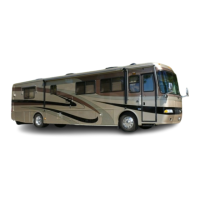Electrical Systems - Chassis
------------------------------------------------------------------------------------------------------------------------------------------------------------------------------------------------------------------------------------------------------------------------------------------------------------------
9•237
PSIG-On fully charged system the expected pressure that should be seen
on the HIGH-SIDE gauge will be around 200 PSGI.
NOTE: All systems are charged at the factory with 4.0 lbs of
R134A.
R-134a Refrigerant:
R134a is classified non-explosive, non-flammable and non-corrosive.
There is hardly any odor and it is much heavier than air. R134a is ozone
friendly; however, it is not technician friendly. Proper care in handling and
adequate ventilation must be observed. Under normal atmospheric pressures
and temperatures R134a will evaporate so quickly it will freeze anything it
comes in contact with. The open container boiling point for R134a is minus
21.7º F. This low boiling point makes for an ideal refrigerant. The tremendous
amount heat transfer which occurs when a liquid boils, or vapors condense,
forms the basic principles of all A/C systems. The amount of heat required to
raise or lower the temperature of one pound of water by 1º F equals one British
Thermal Unit (BTU). The BTU is the standard measurement of an
air conditioner system.
Safety and Handling 134A and Pag Oil:
• When working with any refrigerant system wear eye protection and hand
protection.
• Pag Oil irritates the skin. Flush with water immediately if in
contact with any body part.
• Ensure any service work performed on the A/C system is in a well
ventilated work area.
• Keep open flame away from service area. The discharge of a refrigerant
gas near an open flame can produce a very poisonous gas.
NOTE: O-rings used in a 134A system are Hydrogenated
Nitrile Butadiene Rubber (HNBR). These are green in color
and required for the 134A system.
A/C Heater:
The A/C system will also produce heat to warm the air in the dash area.
Much like the refrigeration side of the system a liquid will be used in the
process. This liquid is the engine coolant. The coolant is passed from the
radiator to an electronic water valve. The water valve, when open, will allow
the coolant to flow through the heater core. The heater core is tubing and fins.
Air is drawn into the system by a blower motor through the outside recircula-
tion door opening. Air is blown through the A/C evaporator core and then
through the heater core. When the temperature control is in the WARM posi-
tion coolant flows through the heater core. When the temperature is in the
COOL position coolant flow bypasses the heater core. In either position the air
flow is felt at the discharge vents.
WINDSOR

